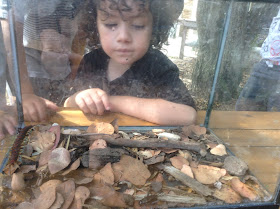The tamariki were very excited last week when a centipede appeared, found at someone’s house! Eek!
This was fantastic timing as the current cricket invasion had been holding a lot of interest for the tamariki. They were excited and interested to move their attention to the centipede.
A great deal of discussion and ideas flew as we watched and observed the centipede.
“He bites and growls and jumps up and he wants to have the alone time. He doesn't like people he runs away”
“He doesn't growl, where’s his mouth?”
“Where’s his eyes”
“He doesn't have eyes”
“He’s not angry, he’s sad, he wants his Mum and Dad”
“Is it a caterpillar?”
“I don’t think a caterpillar has a lots of legs, that has a lots of legs”
“I think it’s a crayfish because it looks like one”
“It’s a centilpedil. I saw one at my house”
“No it’s a cipeda”
“My Mum called it a centipede”
Collaborative learning in small groups aids the exchange of ideas, increases interest among the participants and also promotes critical thinking (Gokhale, 1995).
“He has sharp nails that he walks on”
“Even they can turn their head around and even turn onto their back”
“To turn around?”
“No to see what’s coming behind them”
“I have an idea. He might eat crickets. He might eat the cricket and he might get big”
“Working theories represent the ways children think about, inquire into and make meaning about their worlds as they attempt to make connections between prior and new experiences and understandings” (Hedges).

Claxton (1990) states that “children create minitheories from the knowledge they have so far, and use this to interpret new information and to refine their previous understandings. Learning can be seen as a gradual process of editing and improving these minitheories so that they become more useful and effective, more comprehensive and appropriate, and more connected together”.









No comments:
Post a Comment